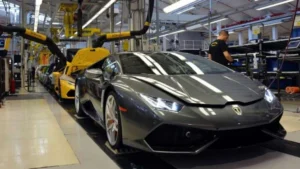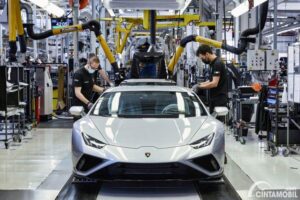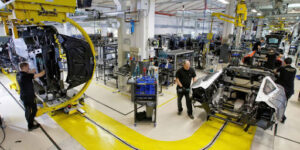Did you know that the Lamborghini supercar manufacturing process uses very little robot assistance?

Lamborghini is made using highly honed and measured artistic techniques using human hands.
Reported from the Digitaltrends.com page, Thursday (3/19/2020), the Lamborghini factory is in Sant’Agata Bolognese, Italy. A small town located about 20 miles from Bologna, and very close to Maranello, where its old rival, Ferrari, is headquartered.

If Maranello has been transformed into a kind of Ferrari tourist location to attract tourists, Sant’Agata has remained an authentic classic for years.
Lamborghini employees work from 8 am to 5 pm from Monday to Friday. And there is no overtime for employees. They all have to go home exactly at 5 pm.
Making process
The most impressive part of the Lamborghini factory is that all Lamborghini supercars are assembled by human hands. In fact, there are only two robots in the entire factory, namely a machine to lower the body onto the assembly line and a rotisserie that turns the car upside down when needed.

The body and panels of the car when they arrive at the factory have been pre-painted and wrapped in a protective plastic layer.
The body of the Lamborghini Huracan supercar is made by Audi’s parent company in Neckarsulm, Germany. And the body of the Lamborghini Aventador supercar is made by an Italian company called Imperiale which assigns one worker to one car for consistency.
The body painting is also done by only one worker to maintain the quality of the painting. The body will be re-checked by a color expert. If there is a part that is not the right color or is uneven, then the body must be repainted. Painting can be done several times until the perfect color results are obtained without defects.
From start to finish, the Aventador takes 18 hours across 12 assembly stations, while the Huracan takes 15 hours and 20 minutes across 23 assembly stations.
Each supercar is built on a separate assembly line, and monitors above each work station track how long the car will be there, helping workers manage their time more efficiently.
Lamborghini doesn’t have a workshop for its signature 10- and 12-cylinder engines. They’re all manufactured by outside suppliers and shipped to the factory, where they’re assembled entirely by hand and tested on the assembly line.
As for the interior, such as the seats, knee rests and door panels, there’s a special booth that can replicate different lighting conditions to help ensure the leather and Alcantara panels that blend together to create the interior are the same color and harmony. The interior parts are only sent to the assembly line for installation after they’ve passed through this booth.

When a supercar is finished, it must go through three final rounds of testing before it’s delivered to its new owner.
The first stage involves using lasers and cameras to check that every part (including the body cuttings related to the suspension and body panels) is precise.
The second step consists of running the car test with a “Dyno” (a special treadmill for vehicles) for 40 minutes at a speed of 180 km/h to ensure that all mechanical components are in good condition. In fact, the Lamborghini supercar is capable of running at speeds above 300 km/h, but for the Dyno test 180 Km/h is enough.
The last step is a test drive at full speed on the quiet, beautiful and green public roads around the factory. Every local resident of all ages often watches every time this fire-breathing “Wild Bull” runs across the streets around them. *

